Negative association of apelin plasma levels with epicardial fat thickness in patients with stable angina and acute myocardial infarction: A case-control study
- PMID: 39239076
- PMCID: PMC11376709
- DOI: 10.4103/jrms.jrms_478_22
Negative association of apelin plasma levels with epicardial fat thickness in patients with stable angina and acute myocardial infarction: A case-control study
Abstract
Background: Apelin is one of the endogenous peptides that play a key role in the homeostasis of cardiovascular diseases. The purpose of the current study was to evaluate the correlation between apelin levels and epicardial fat thickness (EFT) in patients with stable angina and acute myocardial infarction (AMI).
Materials and methods: In a case-control study, 90 patients nominated for angiography were enrolled in the study and divided into three groups: healthy subjects without angiographic findings (Con), stable angina pectoris group (SAP), and acute AMI group. Data collected from all subjects included biochemical, echocardiographic, and angiographical parameters. The Gensini score analyzed the severity of coronary artery disease (CAD).
Results: A decrease in adjusted apelin levels was evident in the AMI and SAP groups compared with healthy individuals (for both P < 0.001), especially in the AMI group. In addition, a detectable negative association was identified between apelin and Gensini score (r = -0.288, P = 0.006), Ck-MB (r = -0.300, P = 0.004), EFT (r = -0.300, P = 0.004), and troponin-T (r = -0.288, P = 0.006).
Conclusion: Myocardial injury in patients with CAD appears to play a significant role in apelin concentration independent of the role of adipose tissue, which requires further studies.
Keywords: Acute myocardial infarction; angiography; apelin; epicardial fat thickness.
Copyright: © 2024 Journal of Research in Medical Sciences.
Conflict of interest statement
There are no conflicts of interest.
Figures



Similar articles
-
Correlation of Serum Adipolin with Epicardial Fat Thickness and Severity of Coronary Artery Diseases in Acute Myocardial Infarction and Stable Angina Pectoris Patients.Med Princ Pract. 2021;30(1):52-61. doi: 10.1159/000508834. Epub 2020 May 21. Med Princ Pract. 2021. PMID: 32438366 Free PMC article.
-
Association of plasma visfatin with epicardial fat thickness and severity of coronary artery diseases in patients with acute myocardial infarction and stable angina pectoris.ARYA Atheroscler. 2022 Jul;18(4):1-10. doi: 10.48305/arya.v18i0.2262. ARYA Atheroscler. 2022. PMID: 36817348 Free PMC article.
-
Correlation of Serum Decoy Receptor 3 and Interleukin-6 with Severity of Coronary Artery Diseases in Male Acute Myocardial Infarction Patients.Acta Biomed. 2021 Nov 3;92(5):e2021285. doi: 10.23750/abm.v92i5.9711. Acta Biomed. 2021. PMID: 34738600 Free PMC article.
-
Serum levels of apelin and ghrelin in patients with acute coronary syndromes and established coronary artery disease--KOZANI STUDY.Transl Res. 2010 May;155(5):238-46. doi: 10.1016/j.trsl.2010.01.004. Epub 2010 Feb 21. Transl Res. 2010. PMID: 20403579
-
API expert consensus document on management of ischemic heart disease.J Assoc Physicians India. 2006 Jun;54:469-80. J Assoc Physicians India. 2006. PMID: 16909697 Review.
Cited by
-
Roles of perivascular adipose tissue in the pathogenesis of atherosclerosis - an update on recent findings.Front Physiol. 2025 Jan 6;15:1522471. doi: 10.3389/fphys.2024.1522471. eCollection 2024. Front Physiol. 2025. PMID: 39835204 Free PMC article. Review.
References
LinkOut - more resources
Full Text Sources
Research Materials
Miscellaneous
